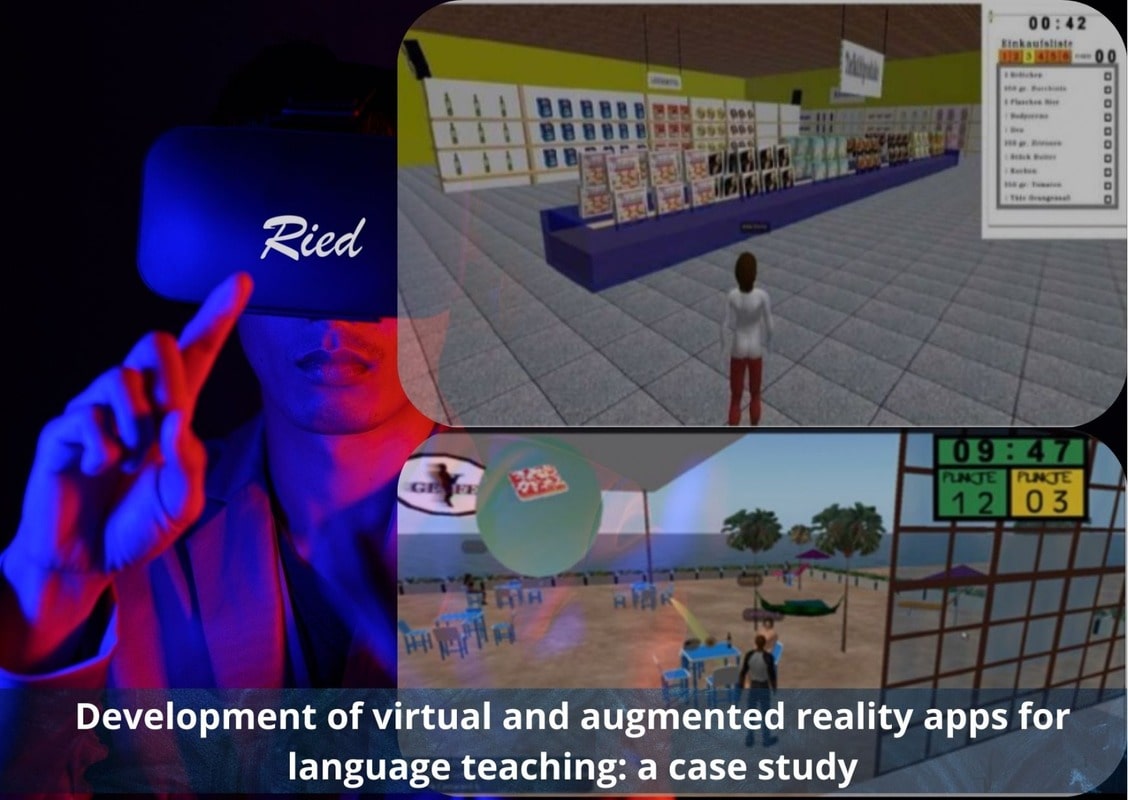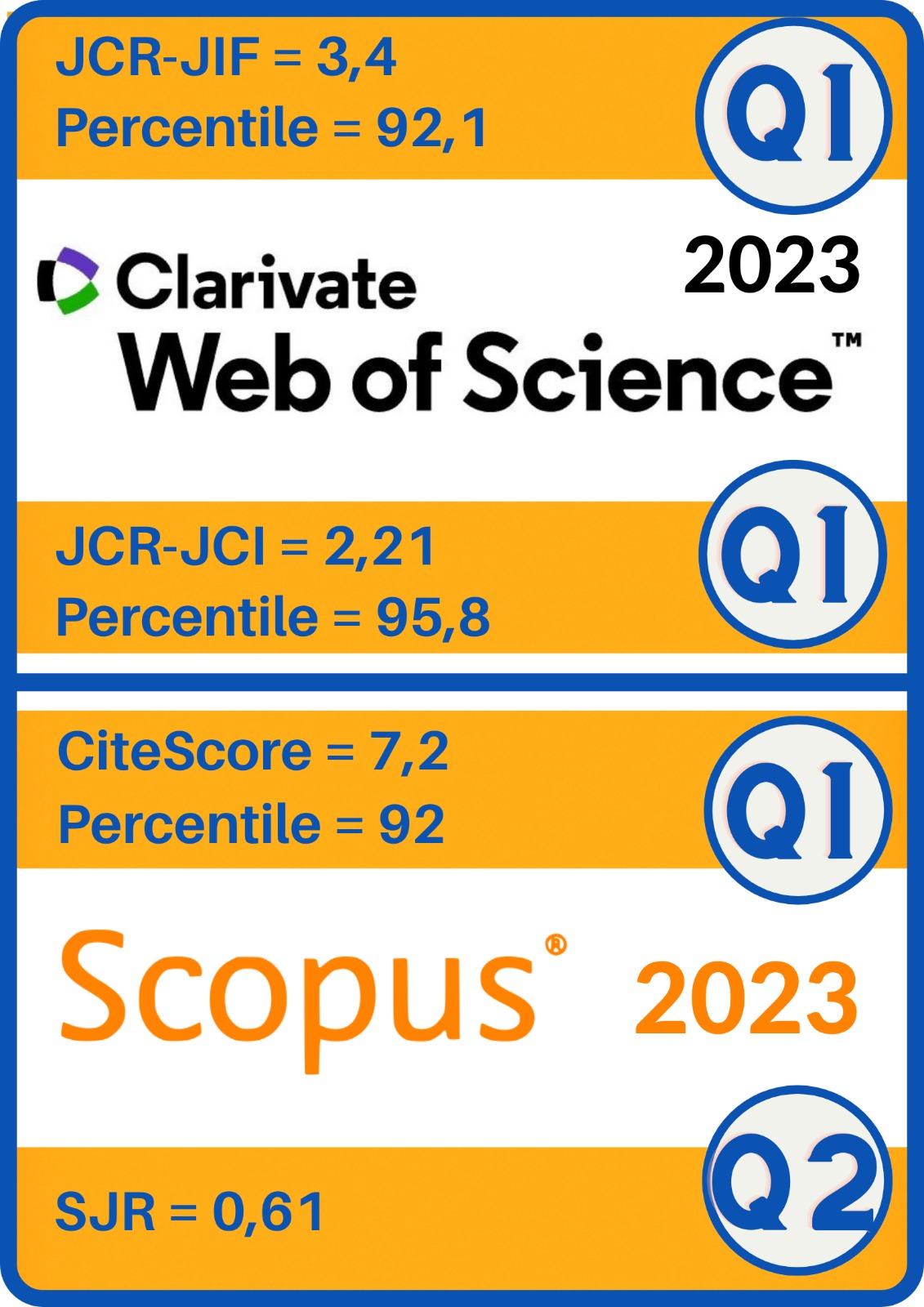Development of virtual and augmented reality apps for language teaching: a case study
DOI:
https://doi.org/10.5944/ried.27.1.37668Keywords:
educational technology, new technologies, language teaching, university studies, case studyAbstract
Technological advances in recent decades and their increasing accessibility pose a constant challenge to teachers. This paper is based on our experience of using digital tools in language teaching, with a particular focus on German as a foreign language. The paper illustrates how we have responded to digital trends in education by gradually incorporating technological resources to facilitate students’ acquisition of language knowledge and skills. In addition, the need to integrate such resources without having specific programming skills and without depending on the support of information technology (IT) staff encouraged us to explore and use development tools, turning us from technology users into developers of our own virtual (VR) and augmented reality (AR) apps. In this context, a case study of 72 university students is presented. The study analyses and compares the educational and motivational potential of the two apps developed by the authors using CoSpaces and ARTutor. The research instrument used was a questionnaire based on the technology acceptance model by Davis (1989), and the results were statistically analysed using SPSS V27. The results of the Wilcoxon test show the suitability and great potential of the developed apps, with no significant differences between them in terms of usefulness or motivational potential. The long-term use of these apps will allow us to analyse their impact compared to other resources, leading to the design of possible improvements.
FULL ARTICLE:
https://revistas.uned.es/index.php/ried/article/view/37668/28168
Downloads
References
Aljawarneh, S. A. (2020). Reviewing and exploring innovative ubiquitous learning tools in higher education. Journal of Computing in Higher Education, 32, 57-73. https://doi.org/10.1007/s12528-019-09207-0
Aydin, S. (2023). Teachers' Perceptions of the Use of the Metaverse in Foreign Language Teaching and Learning. In G. Durak & S. Cankaya, (Eds.), Shaping the Future of Online Learning: Education in the Metaverse (pp. 201-219). IGI Global. https://doi.org/10.4018/978-1-6684-6513-4.ch011
Balderas, A., Berns, A., Palomo-Duarte, M., Dodero, J. M., & Ruiz-Rube, I. (2017). Retrieving objective indicators from student logs in virtual worlds. Journal of Information Technology Research (JITR), 10(3), 69-83. https://doi.org/10.4018/JITR.2017070105
Baena-Pérez, R., Ruiz-Rube, I., Mota, J. M., Berns, A., & Balderas, A. (2022). Visual authoring of virtual reality conversational scenarios for e-learning. Universal Access in the Information Society, 1-18. https://doi.org/10.1007/s10209-022-00934-3
Berns, A., Gonzalez-Pardo, A., & Camacho, D. (2013). Game-like language learning in 3-D virtual environments. Computers & Education, 60(1), 210-220. https://doi.org/10.1016/j.compedu.2012.07.001
Burston, J., & Giannakou, K. (2022). MALL language learning outcomes: A comprehensive meta-analysis 1994–2019. ReCALL, 34(2), 147-168. https://doi.org/10.1017/S0958344021000240
Canto, S., de Graaff, R., & Jauregi, K. (2014). Collaborative tasks for negotiation of intercultural meaning in virtual worlds and video-web communication. In M. González-Lloret & L. Ortega, (Eds.), Technology-mediated TBLT: Researching technology and tasks (pp. 183-212). John Benjamins. https://doi.org/10.1075/tblt.6
Chartrand, R. (2012). Social networking for language learners: Creating meaningful output with Web 2.0 tools. Knowledge Management & E-Learning, 4(1), 97. https://doi.org/10.34105/j.kmel.2012.04.009
Czepielewski, S., Christodoulopoulou, C., Kleiner, J., Mirinaviciute, W., & Valencia, E. (2011). Virtual 3D tools in online language learning. In S. Czepielewski, (Ed.), Learning a Language in Virtual Worlds. A Review of Innovation and ICT in Language Teaching Methodology. V-lang (pp. 7-14). Warsaw Academy of Computer Science, Management and Administration.
Davis, F. D. (1989). Perceived usefulness, perceived ease of use, and user acceptance of information technology. MIS Quarterly, 13(3), 319-340. https://doi.org/10.2307/249008
Dobre, I. (2015). Learning Management Systems for higher education-an overview of available options for Higher Education Organizations. Procedia-Social and Behavioral Sciences, 180, 313-320. https://doi.org/10.1016/j.sbspro.2015.02.122
García Aretio, L. (2019). Necesidad de una educación digital en un mundo digital. RIED-Revista Iberoamericana de Educación a Distancia, 22(2), 9-22. https://doi.org/10.5944/ried.22.2.23911
Garrido-Iñigo, P., & Rodríguez-Moreno, F. (2015). The reality of virtual worlds: Pros and cons of their application to foreign language teaching. Interactive Learning Environments, 23(4), 453-470. https://doi.org/10.1080/10494820.2013.788034
Heil, C. R., Wu, J. S., Lee, J. J., & Schmidt, T. (2016). A review of mobile language learning applications: Trends, challenges, and opportunities. The EuroCALL Review, 24(2), 32-50. https://doi.org/10.4995/eurocall.2016.6402
Hua, C., & Wang, J. (2023). Virtual reality-assisted language learning: A follow-up review (2018-2022). Frontiers in Psychology, 14, 1-13. https://doi.org/10.3389/fpsyg.2023.1153642
Isla-Montes, J.-L., Berns, A., Palomo-Duarte, M., & Dodero, J.-M. (2022). Redesigning a Foreign Language Learning Task Using Mobile Devices: A Comparative Analysis between the Digital and Paper-Based Outcomes. Applied Sciences, 12, 5686. https://doi.org/10.3390/app12115686
Jabbari, N., & Eslami, Z. R. (2019). Second language learning in the context of massively multiplayer online games: A scoping review. ReCALL, 31(1), 92-113. https://doi.org/10.1017/S0958344018000058
Jauregi, K., & Canto, S. (2012). Enhancing meaningful oral interaction in Second Life. Procedia-Social and Behavioral Sciences, 34, 111-115. https://doi.org/10.1016/j.sbspro.2012.02.023
Jauregi-Ondarra, K., & Canto, S. (2022). Interaction games to boost intercultural communication in virtual worlds and video-communication: A case study. In M. Peterson & N. Jabbari, (Eds.), Digital Games in Language Learning (pp. 158-182). Routlegde. https://doi.org/10.4324/9781003240075
Karakaya, K., & Bozkurt, A. (2022). Mobile-assisted language learning (MALL) research trends and patterns through bibliometric analysis: Empowering language learners through ubiquitous educational technologies. System, 102925. https://doi.org/10.1016/j.system.2022.102925
Krashen, S. (2003). Explorations in language acquisition and use. Heinemann.
Kukulska‐Hulme, A., & Viberg, O. (2018). Mobile collaborative language learning: State of the art. British Journal of Educational Technology, 49(2), 207-218. https://doi.org/10.1111/bjet.12580
Lazar, S., & Milena, B. (2013). M-learning-a new form of learning and education. International Journal of Cognitive Research in Science, Engineering and Education, 1(2), 114-118.
Levy, M., & Stockwell, G. (2013). CALL dimensions: Options and issues in computer-assisted language learning. Routledge. https://doi.org/10.4324/9780203708200
López-Belmonte, J., Moreno-Guerrero, A.-J., López-Núñez, J.-A., & Pozo-Sánchez, S. (2021). Scientific production of flipped learning and flipped classroom in Web of Science. Texto Livre: Linguagem e Tecnologia, 14(1), 1-26. https://doi.org/10.35699/1983-3652.2021.26266
López-Belmonte, J., Pozo-Sánchez, S., Moreno-Guerrero, A.-J., & Lampropoulos, G. (2023). Metaverso en Educación: una revisión sistemática. Revista de Educación a Distancia (RED), 23(73). https://doi.org/10.6018/red.511421
Melchor-Couto, S. (2017). Foreign language anxiety levels in Second Life oral interaction. ReCALL, 29(1), 99-119. https://doi.org/10.1017/S0958344016000185
Molka-Danielsen, J., & Deutschmann, M. (2009). Learning and teaching in the virtual world of Second Life. Tapir Academic Press.
Neumann, A. T., Arndt, T., Köbis, L., Meissner, R., Martin, A., De Lange, P., Pengel, P., Klamm, R., & Wollersheim, H. W. (2021). Chatbots as a tool to scale mentoring processes: Individually supporting self-study in higher education. Frontiers in Artificial Intelligence, 4, 668220. https://doi.org/10.3389/frai.2021.668220
Palomo-Duarte, M., Berns, A., Cejas, A., Dodero, J. M., Caballero-Hernández, J. A., & Ruiz-Rube, I. (2018). A Community-Driven Mobile System to Support Foreign Language Learning. In V. Ahuja & S. Rathore, (Eds.), Multidisciplinary Perspectives on Human Capital and Information Technology Professionals (pp. 95-115). IGI Global. https://doi.org/10.4018/978-1-5225-5297-0.ch006
Parmaxi, A., & Demetriou, A. A. (2020). Augmented reality in language learning: A state‐of‐the‐art review of 2014–2019. Journal of Computer Assisted Learning, 36(6), 861-875. https://doi.org/10.1111/jcal.12486
Parmaxi, A. (2023). Virtual reality in language learning: A systematic review and implications for research and practice. Interactive Learning Environments, 31(1), 172-184. https://doi.org/10.1080/10494820.2020.1765392
Peterson, M. (2016). The use of massively multiplayer online role-playing games in CALL: An analysis of research. Computer Assisted Language Learning, 29(7), 1181-1194. https://doi.org/10.1080/09588221.2016.1197949
Romano, M., Díaz, P., & Aedo, I. (2020). Empowering teachers to create augmented reality experiences: the effects on the educational experience. Interactive Learning Environments, 31(3), 1546-1563. https://doi.org/10.1080/10494820.2020.1851727
Souabi, S., Retbi, A., Idrissi, M. K., & Bennani, S. (2021). Towards an Evolution of E-Learning Recommendation Systems: From 2000 to Nowadays. International Journal of Emerging Technologies in Learning (iJET), 16(06), 286-298. https://doi.org/10.3991/ijet.v16i06.18159
Southgate, E., Smith, Sh. P., Cividino, Ch., Saxby, Sh., Kilham, J., Eather, G., Scevak, J., Summerville, D., Buchanan, R., & Bergin, C. (2019). Embedding immersive virtual reality in classrooms: Ethical, organisational and educational lessons in bridging research and practice. International Journal of Child-Computer Interaction, 19, 19-29. https://doi.org/10.1016/j.ijcci.2018.10.002
Tavakoli, R., & Wijesinghe, S. N. (2019). The evolution of the web and netnography in tourism: A systematic review. Tourism Management Perspectives, 29, 48-55. https://doi.org/10.1016/j.tmp.2018.10.008
Terzopoulos, G., Kazanidis, I., Satratzemi, M., & Tsinakos, A. (2021). A Comparative Study of Augmented Reality Platforms for Building Educational Mobile Applications. In M. E. Auer & T. Tsiatsos, (Eds.), Internet of Things, Infrastructures and Mobile Applications. IMCL 2019. Advances in Intelligent Systems and Computing, 1192 (pp. 307-316). Springer. https://doi.org/10.1007/978-3-030-49932-7_30
UN (2019). Informe de los Objetivos de Desarrollo Sostenible 2019. https://unstats.un.org/sdgs/report/2019/The-Sustainable-Development-Goals-Report-2019_Spanish.pdf
UNESCO (2018). Designing inclusive digital solutions and developing digital skills. https://unesdoc.unesco.org/ark:/48223/pf0000265537
Vert, S., & Andone, D. (2019). Virtual reality authoring tools for educators. In N. Herisanu, M. Razzaghi, & R. Vasiu, (Eds.), ITM web of conferences, 29 (pp. 1-7). EDP Sciences. https://doi.org/10.1051/itmconf/20192903008
Xie, H., Chu, H. C., Hwang, G. J., & Wang, C. C. (2019). Trends and development in technology-enhanced adaptive/personalized learning: A systematic review of journal publications from 2007 to 2017. Computers & Education, 140, 103599. https://doi.org/10.1016/j.compedu.2019.103599
Zalite, G. G., & Zvirbule, A. (2020). Digital readiness and competitiveness of the EU higher education institutions: The COVID-19 pandemic impact. Emerging Science Journal, 4(4), 297-304. https://doi.org/10.28991/esj-2020-01232

Downloads
Published
How to Cite
Issue
Section
License
Copyright (c) 2023 Concepcion Valero Franco, Anke Berns

This work is licensed under a Creative Commons Attribution 4.0 International License.
The articles that are published in this journal are subject to the following terms:
1. The authors grant the exploitation rights of the work accepted for publication to RIED, guarantee to the journal the right to be the first publication of research understaken and permit the journal to distribute the work published under the license indicated in point 2.
2. The articles are published in the electronic edition of the journal under a Creative Commons Attribution 4.0 International (CC BY 4.0) license. You can copy and redistribute the material in any medium or format, adapt, remix, transform, and build upon the material for any purpose, even commercially. You must give appropriate credit, provide a link to the license, and indicate if changes were made. You may do so in any reasonable manner, but not in any way that suggests the licensor endorses you or your use.
3. Conditions for self-archiving. Authors are encouraged to disseminate electronically the OnlineFirst version (assessed version and accepted for publication) of its articles before publication, always with reference to its publication by RIED, favoring its circulation and dissemination earlier and with this a possible increase in its citation and reach among the academic community.







